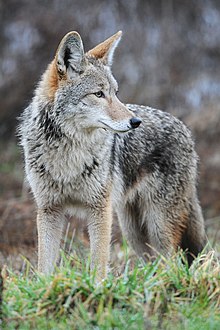You will see coyotes on the golf courses in the winter. I’m not quite sure why they are more prevalent in the winter but it’s most likely due to the absence of humans and this is also their breeding period so they may be more active. Most of the sightings have been around holes 4, 2 and 7 on the South Course.
The following is taken from the MiDNR website where you can find more information on coyotes:
There is wide variation in the coyote's color, but generally their upper body is yellowish gray, and the fur covering the throat and belly is white to cream color. The coyote's ears are pointed and stand erect, unlike the ears of domestic dogs that often droop. When observed running, coyotes carry their bushy, black tipped tail below the level of their back.
Coyotes are opportunistic and will eat almost anything available. They will also prey on unattended small dogs and cats, if opportunities exist. Some coyotes learn to kill smaller livestock, such as sheep, goats, calves, and poultry. Larger animals are almost always consumed as carrion. Coyotes are active day and night; however, peaks in activity occur at sunrise and sunset. Coyotes generally feed at night.
Their presence in subdivisions and urban or suburban areas, while surprising to many folks, is a result of increasing populations (both coyote and human) and encroachment of human environments into their natural habitat (from development of rural areas).
 |
| eastern Coyote photo from wikipedia |






No comments:
Post a Comment